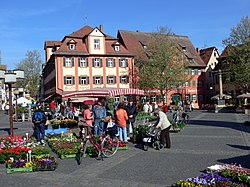
Back Schwabach AN شفاباخ Arabic Şvabax Azerbaijani شواباخ AZB Швабах Bashkir Schwabach BAR Швабах Byelorussian Schwabach Catalan Швабах CE Schwabach (munisipyo) CEB
Schwabach | |
|---|---|
 Market square | |
| Coordinates: 49°19′45″N 11°1′15″E / 49.32917°N 11.02083°E | |
| Country | Germany |
| State | Bavaria |
| Admin. region | Middle Franconia |
| District | Urban district |
| Government | |
| • Lord mayor (2020–26) | Peter Reiß[1] (SPD) |
| Area | |
• Total | 40.71 km2 (15.72 sq mi) |
| Elevation | 326 m (1,070 ft) |
| Population (2023-12-31)[2] | |
• Total | 41,380 |
| • Density | 1,000/km2 (2,600/sq mi) |
| Time zone | UTC+01:00 (CET) |
| • Summer (DST) | UTC+02:00 (CEST) |
| Postal codes | 91101–91126 |
| Dialling codes | 09122, 0911 |
| Vehicle registration | SC |
| Website | www.schwabach.de |
Schwabach (German pronunciation: [ˈʃvaːbax] ⓘ) is a German city of about 40,000 inhabitants near Nuremberg in the centre of the region of Franconia in the north of Bavaria. Together with the neighboring cities of Nuremberg, Fürth and Erlangen, Schwabach forms one of the three metropolitan areas in Bavaria. The city is an autonomous administrative district (kreisfreie Stadt). Schwabach is also the name of the river which runs through the city prior to joining the Rednitz.
Schwabach is famous for its crafts made of gold, particularly gold foil. In 2004, Schwabach celebrated this tradition with an anniversary festival, marking "500 years gold foil in Schwabach".
Around 1500, a local typesetter developed the "Schwabacher" font. This font was used for printing the first Bible in German, which had been worked out by Martin Luther.
- ^ Liste der Oberbürgermeister in den kreisfreien Städten, Bayerisches Landesamt für Statistik, accessed 19 July 2021.
- ^ Genesis Online-Datenbank des Bayerischen Landesamtes für Statistik Tabelle 12411-003r Fortschreibung des Bevölkerungsstandes: Gemeinden, Stichtag (Einwohnerzahlen auf Grundlage des Zensus 2011).




